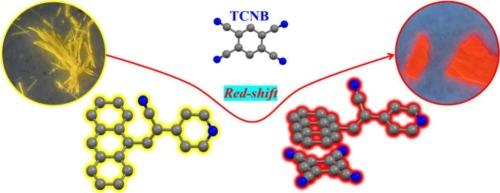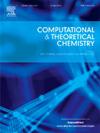Charge-transfer cocrystal engineering of anthracene chalcone compound containing cyano group: DFT-guided modulation of solid-state optical properties
IF 3
3区 化学
Q3 CHEMISTRY, PHYSICAL
引用次数: 0
Abstract
The charge transfer (CT) cocrystal A4BTC of anthracene chalcone compound (αZ)-α-(9-Anthracenylmethylene)-4-pyridineacetonitrile (A4BCN) with 1,2,4,5-Benzenetetracarbonitrile (TCNB) was successfully constructed by supramolecular self-assembly technology. The cocrystal was formed based on π…π interactions in the D…A…D mode was stacked in the solid state. The A4BCN acted as a donor (D) and the electron-deficient TCNB acted as an acceptor (A). The pure phase formation of the cocrystal was confirmed by PXRD and FT-IR analysis. Solid-state optical properties revealed that, in comparison with the donor, A4BTC exhibited a red-shifted UV absorption band of 75 nm and a 73 nm red-shifted fluorescence emission peak. Moreover, the emission quantum yield and fluorescence lifetime showed a remarkable increase. Specifically, the quantum yield was enhanced by a factor of 4.47, and the fluorescence lifetime was extended by 6.9 ns, significantly improving the fluorescence performance. Using Density Functional Theory, the weak intermolecular and π…π interactions in A4BTC were analyzed based on the obtained SXRD crystal data, confirming the CT effect. It could also be inferred that the narrowing of the cocrystal's bandgap due to the CT effect induced a change in the transition dipole moment of the excited state. The change in the excited state dipole moment was directly correlated with the optical properties, thereby achieving the modulation of the optical properties. This study integrated theoretical calculations and experimental investigations, not only clarifying the mechanism by which π…π stacking-mediated CT effect modulates optical properties, but also establishing a theoretical model for the development of high-performance tunable organic fluorescent materials.

含氰基蒽查尔酮化合物的电荷转移共晶工程:dft制导的固态光学性质调制
采用超分子自组装技术成功构建了蒽-查尔酮化合物(αZ)-α-(9-蒽基亚甲基)-4-吡啶乙腈(A4BCN)与1,2,4,5-苯四腈(TCNB)的电荷转移(CT)共晶A4BTC。共晶是基于π…π在D…A…D模式下的相互作用形成的。A4BCN作为供体(D),缺电子的TCNB作为受体(a)。通过PXRD和FT-IR分析证实了共晶的纯相形成。固体光学性质表明,与供体相比,A4BTC具有75 nm的红移紫外吸收带和73 nm的红移荧光发射峰。发射量子产率和荧光寿命均有显著提高。其中,量子产率提高了4.47倍,荧光寿命延长了6.9 ns,显著提高了荧光性能。利用密度泛函理论分析了A4BTC的弱分子间相互作用和π…π相互作用,证实了CT效应。还可以推断,由于CT效应导致的共晶带隙的缩小引起了激发态跃迁偶极矩的变化。激发态偶极矩的变化与光学性质直接相关,从而实现了光学性质的调制。本研究将理论计算与实验研究相结合,不仅阐明了π…π堆叠介导的CT效应对光学性质的调节机制,而且为开发高性能可调谐有机荧光材料建立了理论模型。
本文章由计算机程序翻译,如有差异,请以英文原文为准。
求助全文
约1分钟内获得全文
求助全文
来源期刊

Computational and Theoretical Chemistry
CHEMISTRY, PHYSICAL-
CiteScore
4.20
自引率
10.70%
发文量
331
审稿时长
31 days
期刊介绍:
Computational and Theoretical Chemistry publishes high quality, original reports of significance in computational and theoretical chemistry including those that deal with problems of structure, properties, energetics, weak interactions, reaction mechanisms, catalysis, and reaction rates involving atoms, molecules, clusters, surfaces, and bulk matter.
 求助内容:
求助内容: 应助结果提醒方式:
应助结果提醒方式:


